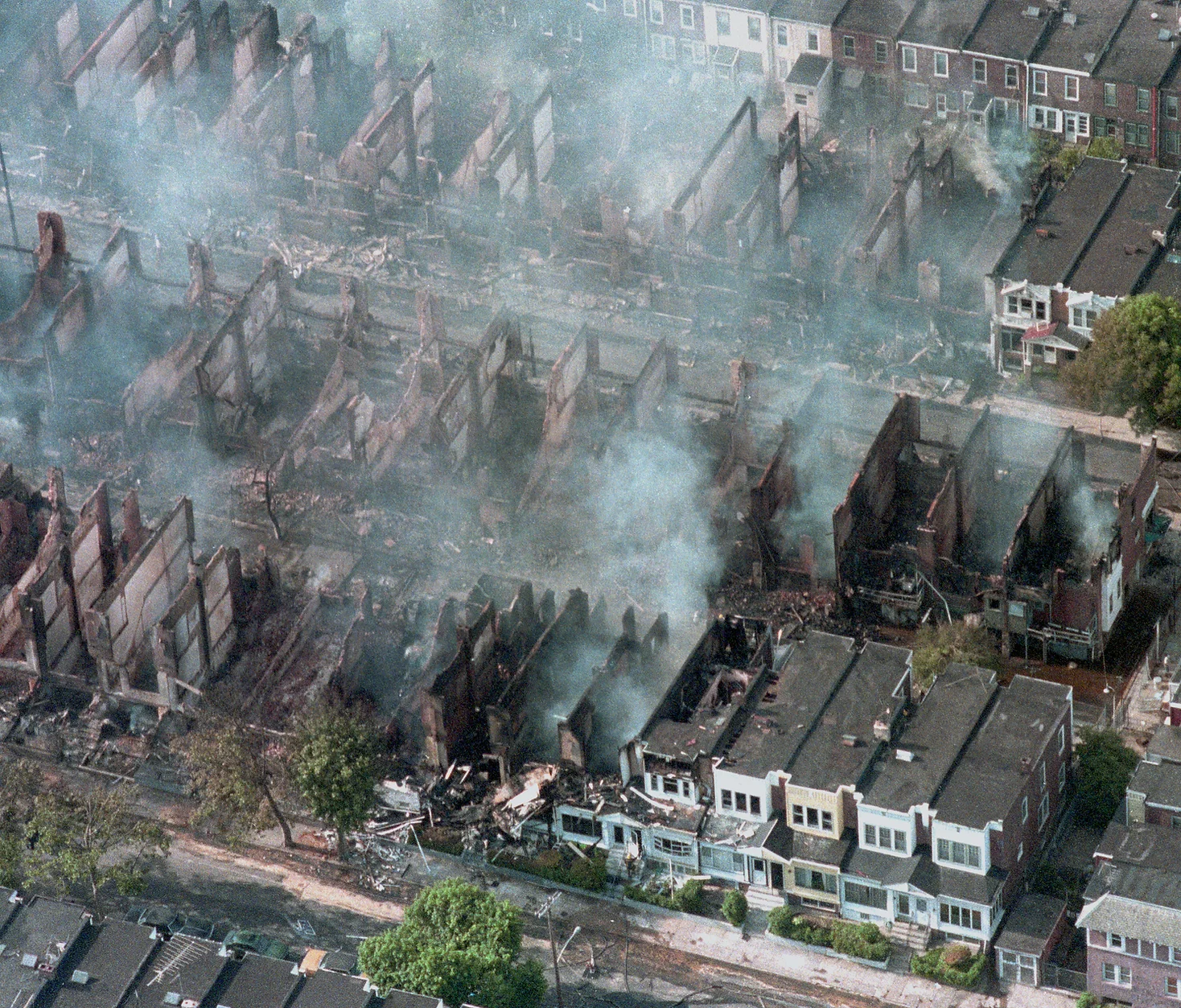Photo by Bettmann Collection/Getty Images
This photograph captures the widespread destruction unleashed in West Philadelphia when the police bombed the MOVE organization on May 13, 1985. The image was originally captioned, “[a]erial view of smoke rising from smouldering [sic] rubble where some 60 homes were destroyed by fire after a shootout and bombing at the back-to-nature terrorist group MOVE’s house in West Philadelphia where police were trying to force the group’s eviction.”
The caption takes a clear position in justification of the gratuitous violence the Philadelphia police employed to remove the group from their home as well as how the day’s events should be remembered. It also reflects not just the individual bias of the archivist who catalogued the photograph, but also the broader antiblack bias that shaped public perceptions of the bombing and the MOVE organization itself. In an updated version of the caption, only the word “terrorist” is removed.
The caption does not, however, address what is obscured from the photograph. The responsibility for the decision to drop a satchel bomb on a residential neighborhood that day sits squarely on Mayor Wilson Goode, the City of Philadelphia, and complicit institutions like the Philadelphia Police Department and University of Pennsylvania.
MOVE, a political and religious organization founded in 1972, has focused on human and animal rights. The group engaged in direct-action protests against war, over-policing, and the inhumane treatment of animals.
Though largely non-violent in their operations, the organization had tenuous relationships with the police and surrounding communities. While many of the organization’s neighbors found their lifestyle to be a nuisance, Philadelphia authorities in the 1970s, especially Mayor Frank Rizzo, worked diligently to disband MOVE.
The bombing was not the organization’s first run-in with the Philadelphia Police Department, but rather the culmination of a series of antagonisms. When a deal MOVE struck with the city to release imprisoned members required them to vacate their Powelton Village compound, it resulted in a standoff that ended in a raid on August 8, 1978, where both MOVE members and the police exchanged gunfire. One officer was killed, and consequently, nine MOVE members were convicted and sentenced to life in prison.
In May 1985, after MOVE relocated to Osage Avenue, the Philadelphia Police Department tried again to evict people from one home. This time, the police were directly responsible for the destruction of entire city blocks and the unhousing of over 250 people because they insisted that the fire burn even after the Philadelphia Fire Department was dispatched.
Eleven people were killed in the fire including five children, while two survivors, Ramona and Birdie Africa, were badly burned. For years following the incident, the City of Philadelphia claimed that the remains of the MOVE victims were cremated.
However, it was discovered in April 2021 that the University of Pennsylvania Museum has been in possession of the remains of Delisha Africa and Katricia Dotson (also known as Tree Africa), 2 and 14 years old at the time of their death, and they had been using them as props in a Coursera course taught by Janet Monge. The remains were returned to family members on July 6, 2021, after protests erupted in West Philadelphia.
Further investigation found a separate set of remains in the Philadelphia Medical Examiner’s Office and that the medical examiner, Tom Farley, had ordered them destroyed without notifying the family of the deceased. The surviving members of the MOVE organization were only able to lay their lost loved ones to rest in Bartram’s Garden 36 years after their deaths.
The treatment of the bodies begs the question, what constitutes terrorism? Political and religious self-determination and civil disobedience, which are constitutional rights of all American citizens, or the bombing of American citizens in a residential neighborhood and the decades long desecration of the remains of those killed because of unjustified violence?
The homes destroyed on 62nd and Osage Avenue remain largely vacant, since many of the families never returned to the neighborhood even after homes of questionable quality were erected in place of the houses lost in the fire. The ghost town on Osage Avenue, which used to be a thriving middle-class Black neighborhood, is itself a memorial to the terrorism that occurred on May 13, 1985.
It also represents the continued antagonism between the Philadelphia Police Department and Black communities in the city. And while most Philadelphia residents are aware of the MOVE bombing, if for no other reason than the huge scar it left on the city, it remains largely forgotten in national memory.
This photograph and the events it captures (and does not capture) should be remembered and memorialized nationwide as the first domestic bombing of its kind, as well as another event establishing the disposability of Black lives in the quest for law and order.

Listen to an interview with Dr. Thompson:
Learn more:
Anderson, John and Hilary Hevenor. Burning Down the House: MOVE and the Tragedy of Philadelphia. W.W. Norton: New York, 1990.
Beckman, Karen. “Black Media Matters: Remembering the Bombing of Osage Avenue.” Film Quarterly (68), no. 4. Summer 2015.
Muhammad, Abdul-Aliy A. “Decades After Philadelphia’s MOVE Bombing, Penn Museum Still Keeps Secrets on the Remains of 12-Year-Old Girl.” Hyperallergic. April 20, 2022. https://hyperallergic.com/725976/philadelphia-move-bombing-penn-museum-still-keeps-secrets-on-the-remains/
Osder, Jason. Let The Fire Burn. Zeitgeist Films, 2013.





